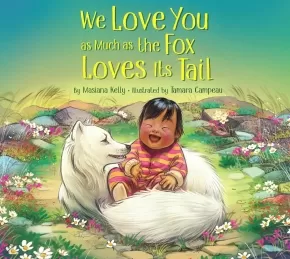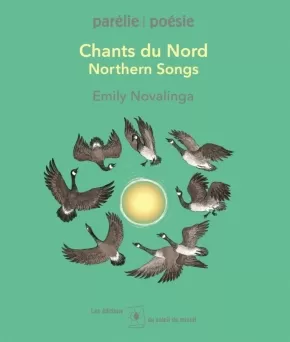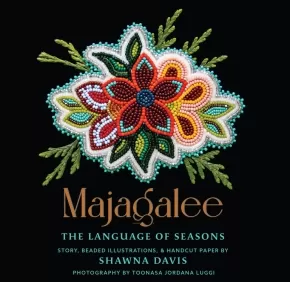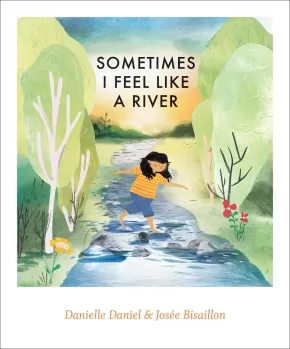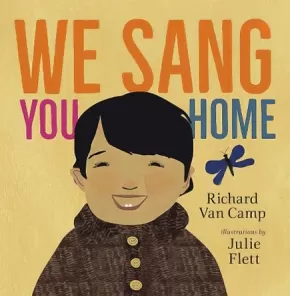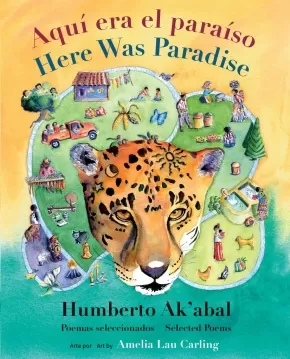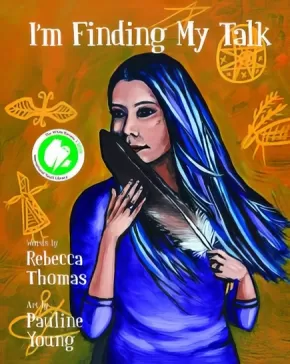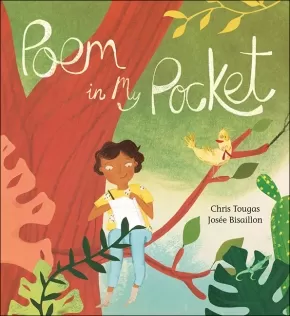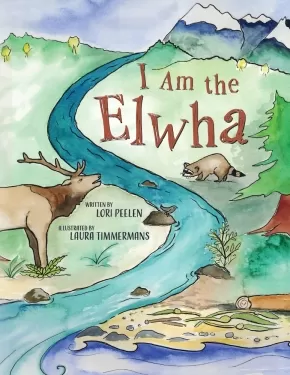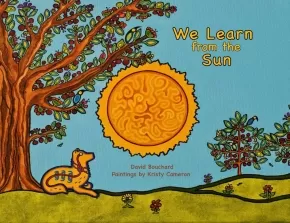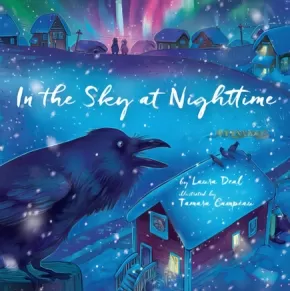
Poetry
16
-
30
of
58 Results;
Sort By
Go To
of 4
We Love You as Much as the Fox Loves Its Tail
$18.95
Artists:
Format:
Hardcover
Text Content Territories:
Indigenous Canadian; First Nations; Dene; Inuit;
ISBN / Barcode: 9781772274769
Synopsis:
Synopsis:
“We’ll love you as much as the narwhal loves its tusk.
We’ll love you as much as the seal loves its musk.
Little One, our new baby,
Welcome to our family.”
This loving bedtime poem shares all the ways in which a family will welcome their long-awaited new member. Sharing love as deep as the beluga dives and as warm as the shaggy hair of the muskox, this poem envelopes a new baby in the embrace of their new home in all its forms—the Arctic landscape and the welcoming arms of family.
Written by Inuk/Dene writer Masiana Kelly, and illustrated with warmth and softness by Tamara Campeau, this sweet and simple narrative celebrates the beauty of creating a family and the unbounding love waiting to be shared with a new little soul.
Educator Information
Recommended for ages 3 to 5.
Additional Information
28 pages | 9.50" x 8.50" | Hardcover
Ancestor Approved: Intertribal Stories for Kids (PB)
$12.50
Editors:
Format:
Paperback
Text Content Territories:
Indigenous American; Native American; Indigenous Canadian;
ISBN / Barcode: 9780062869951
Synopsis:
Synopsis:
Edited by award-winning and bestselling author Cynthia Leitich Smith, this collection of intersecting stories by both new and veteran Native writers bursts with hope, joy, resilience, the strength of community, and Native pride.
Native families from Nations across the continent gather at the Dance for Mother Earth Powwow in Ann Arbor, Michigan.
In a high school gym full of color and song, people dance, sell beadwork and books, and celebrate friendship and heritage. Young protagonists will meet relatives from faraway, mysterious strangers, and sometimes one another (plus one scrappy rez dog).
They are the heroes of their own stories.
Featuring stories and poems by:
Joseph Bruchac
Art Coulson
Christine Day
Eric Gansworth
Carole Lindstrom
Dawn Quigley
Rebecca Roanhorse
David A. Robertson
Andrea L. Rogers
Kim Rogers
Cynthia Leitich Smith
Monique Gray Smith
Traci Sorell,
Tim Tingle
Erika T. Wurth
Brian Young
Reviews
"This uplifting assembly affirms the vitality of Indigenous life today and offers accessible situations and characters to all young readers." — Shelf Awareness
"The entries tell of the personal struggles, family joy, belief systems, and stunning regalia of various nations, including the Cree, Ojibwe, Choctaw, Cherokee, Navajo, Abenaki, and Haudenosaunee, through the eyes of the young protagonists. Enrollment issues, Indian wannabes, and veterans’ histories are just a few of the serious themes addressed in these entertaining stories written by familiar and lesser-known writers alike. Senses of goodwill and humor pervade the book as well as the spirit of community, intersection, resilience, and a desire to remember the past... A joyful invitation to celebrate the circle of ancestors together."— Kirkus Reviews (starred review)
"With exceptionally strong writing throughout, and appended with glossary, author notes, and acknowledgements, this makes an appealing choice for those just learning about contemporary Indigenous life as well as readers well versed with the powwow circuit." — Booklist (starred review)
"Ancestor Approved: Intertribal Stories for Kids is a collection of stories from both new and veteran Indigenous authors. The stories feature a blend of the underlying themes of hope, joy, resilience, the strength of community, and Native pride." - The Dalai Lama Center
Educator Information
Recommended for ages 8 to 12.
Editor Insights: “The contributors joined efforts—by text message, email, and an online message board—to create this engaging collection of interconnected stories, poems, and visual artwork centered on a two-day event, including the characters’ preparations and journeys home.” - Cynthia Leitich Smith
Additional Information
320 pages | 5.12" x 7.62" | Paperback
Chants du Nord: Northern Songs
$12.95
Artists:
ISBN / Barcode: 978-2-924279-24-3
Synopsis:
Synopsis:
Née à Puvirnituq, Emily Novalinga parlait inuktitut et anglais. Elle avait un grand amour des enfants et des mots. Sa poésie est un écho sensible aux différentes réalités nordiques. Ce recueil se veut un hommage à sa vie et à son travail fait dans l’espoir que ses mots continuent de toucher les enfants du Nunavik et d’ailleurs.
Educator Information
Recommended for ages 10+
Dual-language: Poems are written in English and French.
Additional Information
44 Pages
Majagalee: The Language of Seasons
$22.00
Artists:
Format:
Hardcover
Text Content Territories:
Indigenous Canadian; First Nations; Gitxsan (Gitksan);
ISBN / Barcode: 9781990458002
Synopsis:
Synopsis:
Shawna Davis invites the reader to explore each of the four seasons through her beautiful words and lush, unforgettable, beaded illustrations.
We begin in Gwooyim (Spring) when the Majagalee, the Sim Algyax word for “flower,” are just beginning to sprout. We then move on to Sint (Summer) when Grandmother Sun stays in the sky a bit longer. Next there is Xwsit (Fall), just as Summer begins to get sleepy, and Maadim (Winter) where the snow has fallen and the freezer is full.
This is a story of nature, its importance to our lives, and why it must be cared for and respected.
Toonasa Jordana Luggi’s lovely, rich, and nearly tactile photographs are the perfect complement to Shawna’s hand-beaded artwork and wonderful, hand-cut paper backgrounds.
Includes Pronunciation Guides.
Reviews
“...simple, evocative poetry is culturally specific, rooted in a deep love of the land and the people around her but it’s also relatable to readers of different backgrounds. The lyrical verse in Majagalee makes it an ideal read-aloud book.... Majagalee is an elevated concept book. It introduces readers to the seasons, the plants and animals of the Northwest Coast, Sim Algyax, Indigenous art, and the importance of all these things to Gitksan culture. Despite its apparent simplicity, Majagalee is a complex and brilliantly constructed book. It will appeal to Indigenous and non-Indigenous readers alike, and for teachers and parents, it serves as an outstanding example of a book that demonstrates the ongoing presence and beauty of Indigenous cultures in what is now known as Canada..” – Quill & Quire, starred review
Educator Information
Juvenile Fiction. This picture book explores the four seasons on the northwest coast of what is currently British Columbia from a Gitksan perspective.
Additional information
Pages: 40
Sometimes I Feel Like a River
$19.99
Artists:
Format:
Hardcover
Text Content Territories:
Indigenous Canadian;
ISBN / Barcode: 9781773066950
Synopsis:
Synopsis:
Following the huge success of Sometimes I Feel Like a Fox, this companion book is a lyrical celebration of our relationship to the natural world.
In each of twelve short poems, a child tells us how or why they feel like the sun, a river, a mountain, a cloud, the rain, a forest and more. Their deeply felt connections and identification with these wonders point to how much we are all part of the natural world. Each poem comes to life through vivid, playful illustrations that show the children immersed in their surroundings. The book serves as a gentle call to action — to notice, appreciate, preserve and protect our environment, while delighting in all its beauty.
A mindfulness activity — A Mindful Walk or Roll — invites young readers to use their senses to experience their surroundings to the fullest. Includes a brief author’s note that highlights our connections to the natural world.
Educator & Series Information Information
Recommended for ages 3 to 6
This book is part of the Sometimes I Feel Like series.
Key Text Features
- author’s note
- illustrations
- poems
- procedural text
Correlates to the Common Core State Standards in English Language Arts:
CCSS.ELA-LITERACY.RL.K.5
Recognize common types of texts (e.g., storybooks, poems).
CCSS.ELA-LITERACY.RL.1.2
Retell stories, including key details, and demonstrate understanding of their central message or lesson.
CCSS.ELA-LITERACY.RL.1.4
Identify words and phrases in stories or poems that suggest feelings or appeal to the senses.
Additional Information
32 pages | 8.25" x 10.00" | Hardcover
We Sang You Home (HC)
$19.95
Artists:
Format:
Hardcover
Grade Levels: Preschool; Kindergarten;
ISBN / Barcode: 9781459832244
Synopsis:
Synopsis:
A celebration of the bond between parent and child, this is the perfect song to share with your little ones.
In this sweet and lyrical picture book from the creators of the bestselling Little You, gentle rhythmic text captures the wonder new parents feel as they welcome baby into the world.
Internationally renowned storyteller and bestselling author Richard Van Camp teams up with award-winning illustrator Julie Flett for a second time to create a stunning book for young readers.
Reviews
"Both Van Camp's words and Flett's illustrations are economical, but We Sang You Home is not a quick read. Instead, each of the paired pages of text and illustration truly demands that the reader pause and reflect on the pages' contents. Highly recommended." — CM Magazine
"The emotions of parenthood—including feelings of love, elation, and gratitude—are certain to be conveyed to [children] by the parents who share this tale with them. A lovely picture book that will resonate with parents and show young readers the profound, positive impact they have on their parents' lives." — School Library Journal
"Babies and toddlers love to be loved, and they will also love to see themselves and their parents reflected in the beautiful pages of this book." — Canadian Children's Book News
"A great strength of this book is that it is nonspecific and inclusive enough to encompass all new babies—arriving through birth, fostering, or adoption—and it does not specify gender…The whole message is one of love, welcome, and completion now that the young one has joined the family. The eye-catching illustrations hint at a non-specific non-white race for the family (could be Asian, First Nations, Inuit, etc.), making this book inclusive and encompassing of Canada's ethnic diversity…It is a book of thankfulness and hope that would make a wonderful addition to the preschool collection in a library. Highly recommended." — Resource Links
"We Sang You Home is a gentle story about a parent's unconditional love for a child. The lullaby-style story is a great way to share connections between young readers and their adults." — The Dalai Lama Center
Educator Information
Recommended for ages 2 and under.
This book is available in a board book format: We Sang You Home
This book is available in a dual-language format: We Sang You Home / Ka Kîweh Nikamôstamâtinân
Additional Information
32 pages | 8.00" x 8.00" | Hardcover
Authenticity Note: This story is meant to appeal to and honour a variety of families, not only Indigenous families. This is why we have labelled it as not containing Indigenous text content; it may still work as an Indigenous text for your purposes, though, as the author and illustrator are in Indigenous.
Aquí era el paraíso / Here Was Paradise (1 in stock, in reprint)
$19.99
Artists:
Format:
Hardcover
Text Content Territories:
Indigenous Central American; Maya;
ISBN / Barcode: 9781773064956
Synopsis:
Synopsis:
A collection of poetry by one of the greatest Indigenous poets of the Americas about the vanished world of his childhood — that of the Maya K’iche’.
Aquí era el paraíso / Here Was Paradise is a selection of poems written by the great Maya poet Humberto Ak’abal. They evoke his childhood in and around the Maya K’iche’ village of Momostenango, Guatemala, and also describe his own role as a poet of the place.
Ak’abal writes about children, and grandfathers, and mothers, and animals, and ghosts, and thwarted love, and fields, and rains, and poetry, and poverty, and death.
The poetry was written for adults but can also be read and loved by young people, especially in this collection, beautifully illustrated by award-winning Guatemalan-American illustrator Amelia Lau Carling.
Ak’abal is famous worldwide as one of the great contemporary poets in the Spanish language, and one of the greatest Indigenous poets of the Americas. Ak’abal created his poems first in K’iche’, then translated them into Spanish.
Educator Information
Recommended for ages 9+.
Dual-language in English and Spanish.
Key Text Features: foreword, biographical information, poems, translation
Correlates to the Common Core State Standards in English Language Arts:
CCSS.ELA-LITERACY.RL.4.2
Determine a theme of a story, drama, or poem from details in the text; summarize the text.
CCSS.ELA-LITERACY.RL.5.4
Determine the meaning of words and phrases as they are used in a text, including figurative language such as metaphors and similes.
CCSS.ELA-LITERACY.RL.5.5
Explain how a series of chapters, scenes, or stanzas fits together to provide the overall structure of a particular story, drama, or poem.
CCSS.ELA-LITERACY.RL.5.7
Analyze how visual and multimedia elements contribute to the meaning, tone, or beauty of a text (e.g., graphic novel, multimedia presentation of fiction, folktale, myth, poem).
CCSS.ELA-LITERACY.RL.6.2
Determine a theme or central idea of a text and how it is conveyed through particular details; provide a summary of the text distinct from personal opinions or judgments.
CCSS.ELA-LITERACY.RL.6.5
Analyze how a particular sentence, chapter, scene, or stanza fits into the overall structure of a text and contributes to the development of the theme, setting, or plot.
Excerpt from the Introduction by Patricia Aldana: "In this book we find poems about children, and grandfathers, and mothers, and animals, and ghosts, and thwarted love, and fields, and rains, and poetry, and poverty, and death. Ak'abal never pretended that life in his world was easy. The history of Guatemala is complex. It has the highest Indigenous population as a percentage of any country in the Americas. And Maya people have suffered terrible discrimination, violence and poverty since the arrival of the Europeans. But Ak'abal's poems convey how all his world's elements also came together to create a deep, rich reality.... Reading these wonderful poems can remind us that it is still possible to fight to protect this beautiful world and the people who live in and on it."
Additional Information
172 pages | 6.50" x 8.31" | 14 Colour Illustrations | Hardcover | Translated by Hugh Hazelton
I Lost My Talk (PB)
$13.95
Artists:
Format:
Paperback
Text Content Territories:
Indigenous Canadian; First Nations; Mi'kmaq;
ISBN / Barcode: 9781774710050
Synopsis:
Synopsis:
I lost my talk
The talk you took away
When I was a little girl
At Shubenacadie school.
One of Rita Joe's most influential poems, "I Lost My Talk" tells the revered Mi'kmaw Elder's childhood story of losing her language while a resident of the residential school in Shubenacadie, Nova Scotia. An often quoted piece in this era of truth and reconciliation, Joe's powerful words explore and celebrate the survival of Mi'kmaw culture and language despite its attempted eradication.
A companion book to the simultaneously published I'm Finding My Talk by Rebecca Thomas, I Lost My Talk is a necessary reminder of a dark chapter in Canada's history, a powerful reading experience, and an effective teaching tool for young readers of all cultures and backgrounds. Includes a biography of Rita Joe and striking colour illustrations by Mi'kmaw artist Pauline Young.
Reviews
"This picture book version of I Lost My Talk is best read with Rebecca Thomas’s I’m Finding My Talk. These haunting, evocative books bring an original approach to the exploration of Canadian residential schools in picture books. For readers and teachers who appreciate fact-based information, there is also “A Short History of Residential Schools” at the end of I Lost My Talk. Educators, librarians, and families will find their classrooms and book collections invaluably enriched by these books. They are real tools of truth and reconciliation; as such, they belong on every bookshelf in Canada and beyond." - CM Reviews
Educator Information
Recommended for ages 4 to 9.
This work features a short history of residential schools and information about the author.
Recommended in the Canadian Indigenous Books for Schools 2020/2021 resource list for grades 1-7 for English Language Arts.
Additional Information
32 pages | 8.00" x 10.00"
I'm Finding My Talk (PB)
$13.95
Artists:
Format:
Paperback
Text Content Territories:
Indigenous Canadian; First Nations; Mi'kmaq;
ISBN / Barcode: 9781774710067
Synopsis:
Synopsis:
I'm finding my talk
And it may take some time,
But I'm learning to speak
In a language that's mine.
A response to Rita Joe's iconic poem "I Lost My Talk," and published simultaneously with the new children's book edition illustrated by Pauline Young, comes a companion picture book by award-winning spoken-word artist and Mi'kmaw activist Rebecca Thomas. A second-generation residential school survivor, Thomas writes this response poem openly and honestly, reflecting on the process of working through the destructive effects of colonialism.
From sewing regalia to dancing at powow to learning traditional language, I'm Finding My Talk is about rediscovering her community, and finding culture. Features stunning, vibrant illustrations by Mi'kmaw artist Pauline Young.
Reviews
"Published as a companion to the picture book I Lost My Talk, featuring the famous poem by Rita Joe, both volumes explore the legacy of Canada’s residential schools. They feature vibrant illustrations by Pauline Young that bring the words alive with emotional nuance. This remarkable pair of books possesses the rare ability of being suited to readers of all ages: three to six-year-olds, the traditional intended audience of picture books, will be captivated by the bright, lively illustrations; elementary and middle school children will find their Social Studies curriculum enriched by experiencing these important concepts rendered creatively; teens and adults will gain insight and empathy by enjoying these beautiful poems." - CM Reviews
"[A]n honest reflection on the process of working through the destructive effects of colonialism by participating in cultural connections. This book offers the opportunity to show the journey one takes when rediscovering their community and culture." - The Dalai Lama Center
Educator Information
Recommended for ages 4 to 9.
Recommended in the Canadian Indigenous Books for Schools 2020/2021 resource list for grades 1-3 in the areas of Social Studies and Language Arts.
Former Halifax Poet Laureate and second-generation residential school survivor Rebecca Thomas writes honestly and powerfully in this companion piece to Rita Joe's I Lost My Talk. Includes vibrant illustrations from Mi'kmaw artist Pauline Young.
Additional Information
32 pages | 8.00" x 10.00"
Mii maanda ezhi-gkendmaanh / This Is How I Know
$19.99
Format:
Hardcover
Text Content Territories:
Indigenous Canadian; First Nations; Anishinaabeg;
ISBN / Barcode: 9781773063263
Synopsis:
Synopsis:
Niibing, dgwaagig, bboong, mnookmig dbaadjigaade maanpii mzin'igning / A Book about the Seasons.
An Anishinaabe child and her grandmother explore the natural wonders of each season in this lyrical, bilingual story-poem.
In this lyrical story-poem, written in Anishinaabemowin and English, a child and grandmother explore their surroundings, taking pleasure in the familiar sights that each new season brings.
We accompany them through warm summer days full of wildflowers, bees and blueberries, then fall, when bears feast before hibernation and forest mushrooms are ripe for harvest. Winter mornings begin in darkness as deer, mice and other animals search for food, while spring brings green shoots poking through melting snow and the chirping of peepers.
Brittany Luby and Joshua Mangeshig Pawis-Steckley have created a book inspired by childhood memories of time spent with Knowledge Keepers, observing and living in relationship with the natural world in the place they call home — the northern reaches of Anishinaabewaking, around the Great Lakes.
Alvin Ted Corbiere and Alan Corbiere, father and son, are the Anishinaabe translators of this work.
Awards
- 2022 Indigenous Voices Award for a published work in an Indigenous language
Educator Information
Recommended for ages 3 to 7.
Correlates to the Common Core State Standards in English Language Arts:
CCSS.ELA-LITERACY.RL.2.1
Ask and answer such questions as who, what, where, when, why, and how to demonstrate understanding of key details in a text.
CCSS.ELA-LITERACY.RL.2.2
Recount stories, including fables and folktales from diverse cultures, and determine their central message, lesson, or moral.
CCSS.ELA-LITERACY.RL.K.6
With prompting and support, name the author and illustrator of a story and define the role of each in telling the story.
CCSS.ELA-LITERACY.RL.1.4
Identify words and phrases in stories or poems that suggest feelings or appeal to the senses.
CCSS.ELA-LITERACY.RL.2.5
Describe the overall structure of a story, including describing how the beginning introduces the story and the ending concludes the action.
How do you know the seasons? Do you know it's summer when blueberries fall readily and the sand is hot enough to sting? Do you know fall by the red-winged blackbird taking his leave? Take a minute and look around — nature is speaking to us. Changes are happening, and Mother Earth is letting us know at every step of the way. Whether it's the sun's bright morning light, or the white moon sitting high in the sky, there are many ways to know what time of the year it is. All we need to do is stop, look, and listen, because each season tells us a story!
This book is also available in French and Ojibwe: Mii maanda ezhi-gkendmaanh / La Terre me parle: Un livre sur les saisons
Additional Information
44 pages | 8.75" x 8.50"
Poem in My Pocket
$17.99
Artists:
Format:
Hardcover
ISBN / Barcode: 9781525301452
Synopsis:
Synopsis:
In this charming picture book allegory of the creative writing process, happenstance and weather events symbolize the emotional ebb and flow of writing a poem.
I had a poem in my pocket,
but my pocket got a rip.
Rhymes tumbled down my leg
and trickled from my hip.
Thus begins the journey of a young poet's words out into the world, where they join randomly with other words to form funny riffs and puns all over a busy city street. The child scrambles to capture the loose words and arrange them back into poem form, only to lose them again as a storm swoops in on a rushing wind. Eventually, the words plant themselves in the muddy ground, where they grow into something that might be even better than the original poem: a Poet-Tree.
Not only a fanciful rhyming adventure tale, Chris Tougas's picture book is also a delightful allegory for the creative writing process. Perfect for classroom discussions about the emotional ups and downs of writing, this highly innovative book celebrating poetry and creativity is an excellent choice for National Poetry Month. It also showcases the magic of language and how much fun words can be. High-energy artwork by Josée Bisaillon is so full of words in flight and at play that children can pore over it again and again, and in the final spread, readers can search for rhyming pairs. An afterword discusses National Poetry Month and Poem in Your Pocket Day. This is a book that adult writers will also appreciate.
Reviews
"This is a whimsical, rhyming story that gives expression to the long frustration and toil that's often part of the artistic process." —Booklist
"This book about wordplay strikes the write balance between silly and sincere."—Kirkus Reviews
Educator Information
Recommended for ages 4 to 7.
Lexile Code: Adult Directed
Lexile Level: 570
Additional Information
24 pages | 9.15" x 10.35" | Hardcover
I Am the Elwha (HC)
 $18.50
$18.50

Artists:
Format:
Hardcover
Text Content Territories:
Indigenous American; Native American; Salish; Coast Salish; Klallam (Clallam); Lower Elwha Klallam Tribe;
ISBN / Barcode: 9781771744744
Synopsis:
Synopsis:
“I am the Elwha, rushing down to the sea. I am the Elwha, wild and free.”
The Elwha River flows 72 kilometres (45 miles) from its source in the Olympic Mountains to the Strait of Juan de Fuca in the Pacific Northwest. Uniquely, it hosts all six salmon species (Pink, Chinook, Coho, Sockeye, Steelhead, and Chum) as well as several species of trout.
In 1911 two dams were built on the river. The dams blocked the migration routes of the salmon and dramatically altered the entire river ecosystem for 100 years. In 2012 the dams were decommissioned and the world’s largest dam removal and habitat restoration project began.
In this lyrical and beautifully illustrated book, the author chronicles the history of the Elwha. Narrated by the powerful voices of plants and animals that inhabit the river ecosystem, the dam builder, a worker, and the river itself, this story celebrates the ongoing rewilding of this special environment and offers a welcome to all of the creatures who are coming home.
To learn more visit: www.elwha.org
Awards
- 2021 Riverby Award for Young Readers
Reviews
“I Am the Elwha is a powerful read about a powerful river and those who value and protect it." – Raina Delisle, Hakai Magazine
Educator Information
At the back of the book are three pages of cultural, scientific, and historical information that discuss the following:
- the importance and symbolism of salmon to the Lower Elwha Klallam Tribe and other Coastal Salish Tribes
- facts about the six species of salmon found in the Elwha River (Chinook, Pink, Chum, Sockeye, Coho, and Steelhead)
- the history of the Elwha River and its status today
Keywords / Subjects: The Elwha River, Rivers, Dams, History, Environmental Awareness, Lower Elwha Klallam Tribe, Coast Salish, Native American, Culture, Washington, Animals, Salmon, First Salmon Ceremony, Plants, Nature, Settlers, Social Responsibility, Environmental Activism, Poetry.
Recommended for grades 3 to 7.
Additional Information
32 Pages | 8.5" x 11" | ISBN: 9781771744744 | Hardcover
Authenticity Note: This lyrical story, which chronicles the history of the Elwha River, is written by Lori Peelen. Robert Elofson, Tribal Elder and Harvest Manager in the Natural Resources Department for the Lower Elwha Klallam Tribes, approved Lori's work and contributed a few pages of back matter at the end of the work. Lori's story was further approved by Frances Charles, the Tribal Councilwoman for the Lower Elwha Klallam Tribe, after the entire council read and approved it.
The Canadian Content label has been applied because the illustrator of this work is Canadian.
We Learn from the Sun (HC)
$22.99
Artists:
Format:
Hardcover
Text Content Territories:
Indigenous Canadian; First Nations; Anishinaabeg;
ISBN / Barcode: 9781989122396
Synopsis:
Synopsis:
This richly illustrated book by writer David Bouchard and illustrator Kristy Cameron, weaves together Woodland style paintings with a rhythmic poem about the spiritual lessons that we can learn from the Sun and the seven sacred teachings.
Educator Information
David Bouchard is a bestselling author, speaker and educator. He is Canada’s most sought after public speaker. We Learn from the Sun is an Indigenous rhyming poem based on his best selling book Seven Sacred Teachings.
An accompanying lesson plan and resource guide entitled We Learn from the Sun: Lesson Plans and Resources can be found on our site as well.
This book is available in French: On apprend du soleil.
Recommended for ages 5 to 12.
This resource is included in the Canadian Indigenous Books for Schools 2020/2021 resource list for grades K to 7 for Language Arts.
Additional Information
34 pages | 11.00" x 9.00" | 26 colour illustrations
If Instead of a Person
$14.00
Artists:
Format:
Paperback
Text Content Territories:
Indigenous Canadian; First Nations; Salish; Coast Salish;
ISBN / Barcode: 9780995012769
Synopsis:
Synopsis:
If Instead of a Person imaginatively explores the wisdom to be learned from living as a tree. Using child-friendly rhyming verse, Coast Salish author Courtney Defriend ponders a tree's steadfast connection and vital contribution to life on earth. Reinforced by Terra Mar's powerful illustrations, If Instead of a Person invites readers to become change agents that respect the interconnectedness of nature and humanity.
Educator Information
Partial proceeds go to Tillicum Lelum Aboriginal Friendship Centre.
Recommended for ages 4 to 10.
Juvenile Fiction, Indigenous Resource, Poetry, Environmental.
Additional Information
8.25" x 8.25"
In the Sky at Nighttime
$16.95
Artists:
Format:
Hardcover
Grade Levels: Preschool;
ISBN / Barcode: 9781772272383
Synopsis:
Synopsis:
In the sky at nighttime the northern lights dance, a mothers song sways on the breeze, and a raven roosts atop a tall building, bathed in the white of the moon.
This lyrical poem sends readers sailing through the Arctic night sky to see and hear the unique beauty of a Northern night.
Educator Information
Recommended for ages 3 and under.
Additional Information
36 pages | 8.50" x 8.50"
Sort By
Go To
of 4

